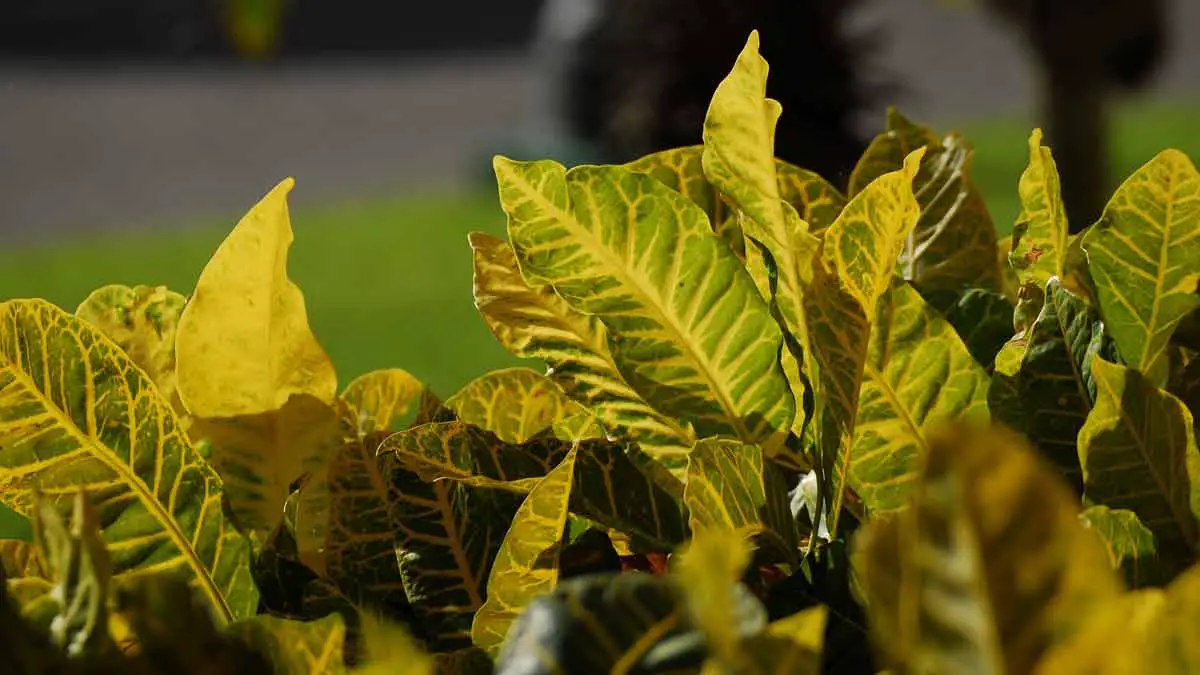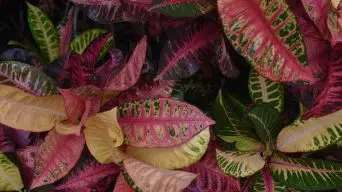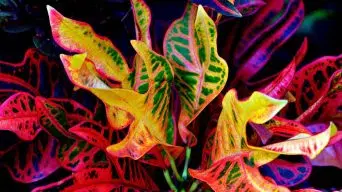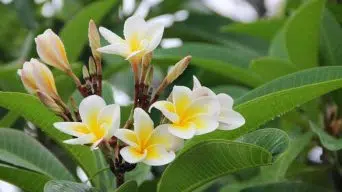Croton plants are native to the tropical regions of South America, Asia, and Australia.
In the wild, they can grow up to 16 feet tall, but they are typically much smaller when grown in pots.
Crotons are known for their brightly colored leaves, which can be variegated with shades of yellow, orange, red, or green.
Croton plants are relatively easy to care for, but they can sometimes suffer from problems, such as yellow leaves.
Here you’ll find the most common reasons why your Croton leaves are turning yellow, along with solutions to help your plant recover.
What Causes Croton Leaves to Turn Yellow?
There are several reasons why Croton leaves may turn yellow.
Some are due to problems with the plant, while others are due to environmental factors.
Here are 11 possible causes for yellowing Croton leaves and what you can do about them.
1. Overwatering
Overwatering is one of the most common reasons for Croton leaves to turn yellow.
Crotons are native to tropical regions and prefer evenly moist soil.
However, they cannot tolerate soggy or waterlogged conditions.
When the plant is overwatered, the roots cannot get the oxygen they need and begin to suffocate. This leads to several problems, such as CRoton leaves turning yellow.
How To Tell If You Are Overwatering Your Croton Plant
There are a few telltale signs that your Croton plant is being overwatered.
- The leaves will begin to turn yellow, starting at the bottom of the plant and working up.
- The leaves may also develop brown spots or patches.
- The stems may become soft and mushy.
- The plant may become stunted or stop growing altogether.
How To Fix An Overwatered Croton Plant
If you think your Croton is being overwatered, you can do a few things to save the plant.
- Check the soil. The first step is to check the soil. Is it soggy or waterlogged? If so, you will need to take action to improve the drainage.
- Improve the drainage. If the soil is too wet, you must improve the drainage. This can be done by adding sand, perlite, or grit to the potting soil mix.
- Let the soil dry out. Once you have improved the drainage, let the soil dry out completely before watering again. This will give the roots a chance to recover.
- Reduce watering. Once the plant has recovered, water only when the soil is dry. Water less often in winter.
- Check the roots. If the roots are mushy or have started to rot, you must repot the plant in a fresh potting mix.
2. Underwatering
While overwatering is a common problem, underwatering can also cause Croton leaves to turn yellow.
Crotons require evenly moist soil, so if the soil is allowed to dry out, the plant will suffer.
When plants don’t have enough water, they will begin to wilt. The Croton leaves will start to droop and turn yellow.
The leaves will eventually turn brown and die if the plant is not watered soon.
How To Tell If You Are Underwatering Your Croton Plant
There are a few signs that your Croton plant is not getting enough water.
- The leaves will begin to wilt and droop.
- The leaves may also develop brown spots or patches.
- The plant may become stunted or stop growing altogether.
How To Fix An Underwatered Croton Plant
If you think your Croton is not getting enough water, you can do a few things to help the plant recover.
- Water the plant thoroughly. The first step is to water the plant thoroughly. Be sure to wet the soil all the way through.
- Increase watering. Once the plant has recovered, be sure to water it more frequently. Water when the top inch of soil is dry.
- Give the plant a humidity tray. Another way to increase humidity is to place the plant on a humidity tray. This will help the plant to recover and prevent future problems.
3. Lack of Light
Another common reason Croton leaves turn yellow is a lack of light.
Crotons are native to tropical regions and prefer bright indirect light.
If the plant is not getting enough light, the leaves will begin to turn yellow. The plant may also become leggy and stop growing.
How To Tell If Your Croton Is Not Getting Enough Light
There are a few signs that your Croton is not getting enough light.
- Discolored leaves: If the leaves are turning yellow, this is a sign that the plant is not getting enough light.
- Stretching: If the plant is stretching out and becoming leggy, this is another sign that it is not getting enough light.
- Slow growth: Crotons are fast-growing plants, and if the plant is not growing quickly, it is likely not getting enough light.
How To Fix A Croton That Is Not Getting Enough Light
If you think your Croton is not getting enough light, you can do a few things to help the plant.
- Move the plant to a brighter location. The first step is to move the plant to a brighter place. If possible, choose a spot that receives bright light.
- Add a grow light. If you cannot find a brighter spot, you may need to add a grow light. This will provide the plant with the light it needs to recover.
4. Too Much Sunlight
While Croton plants need a lot of light, too much direct sunlight can cause problems.
If the plant is in a spot that receives too much direct sunlight, the leaves will begin scorching. The leaves will turn yellow or brown and may eventually fall off the plant.
How To Tell If Your Croton Is Getting Too Much Sunlight
There are a few signs that your Croton is getting too much sunlight.
- Scorched leaves: If the leaves are turning yellow or brown, this is a sign that the plant is getting too much sunlight.
- Dropping leaves: If the plant is losing leaves, it is another sign of getting too much sunlight.
- Brown spots on leaves: Brown spots on the leaves can also be a sign of too much sunlight.
How To Fix A Croton That Is Getting Too Much Sunlight
If you think your Croton is getting too much sunlight, you can do a few things to help the plant.
- Move the plant to a shadier spot. The first step is to move the plant to a darker location. If possible, choose a place that receives bright indirect light.
- Add a sheer curtain. Another way to filter the sunlight is to add a sheer curtain over the window. This will help to soften the light and prevent scorching.
5. Overfertilization
Overfertilizing is another common reason for Croton leaves to turn yellow.
Crotons are heavy feeders and need a lot of fertilizer to stay healthy. However, too much fertilizer can be just as harmful as not enough.
If the plant is getting too much fertilizer, the roots will become burned, and the plant won’t be able to absorb the nutrients it needs. This will cause the leaves to turn yellow and eventually die.
How To Tell If Your Croton Is Overfertilized
There are a few signs that your Croton is overfertilized.
- Yellowing leaves: If the leaves are turning yellow, this is a sign that the plant is not getting enough nutrients.
- Brown leaves: If the leaves are turning brown, this is another sign that the plant is not getting enough nutrients.
- Wilting: If the plant is wilting, this is a sign that the roots are burned and the plant can’t absorb water.
How To Fix A Croton That Is Overfertilized
If you think your Croton is overfertilized, you can do a few things to help the plant.
- Flush the soil. The first step is to flush the soil with water. This will help to remove some of the excess fertilizer from the roots.
- Repot the plant. If the plant is in a pot, you may need to repot it to eliminate all the excess fertilizer.
- Cut back on fertilizer. Once you have flushed the soil and repotted the plant, you will need to cut back on the fertilizer you use.
6. Nutrient Deficiencies
Nutrient deficiencies are another common reason for Croton leaves to turn yellow.
Crotons need a lot of nutrients to stay healthy, and if they are not getting enough, the plant leaves will begin to turn yellow.
The most common nutrient deficiencies include nitrogen, iron, and magnesium.
Nutrient deficiencies can be caused by several things, including poor soil, overwatering, and underfertilizing.
How To Tell If Your Croton Has A Nutrient Deficiency
There are a few signs that your Croton has a nutrient deficiency.
- Discolored leaves: If the leaves are discolored, this is a sign that the plant is not getting enough nutrients.
- Yellow leaves: If the leaves turn yellow, this is another sign that the plant is not getting enough nutrients.
- Brown spots on leaves: Brown spots on the leaves can also be a sign of a nutrient deficiency.
- Stunted growth: If the plant’s growth is stunted, this is a sign that the plant is not getting enough nutrients.
How To Fix A Croton With A Nutrient Deficiency
If you think Croton has a nutrient deficiency, you can do a few things to help the plant.
- Fertilize the plant. The first step is to fertilize the plant with a high-quality fertilizer.
- Add organic matter to the soil. Adding organic matter to the soil will help improve the soil quality and make it easier for the plant to absorb nutrients.
- Repot the plant. If the plant is in a pot, you may need to repot it in fresh soil to help the plant get the nutrients it needs.
7. Transplant Shock
Transplant shock is another common reason for Croton leaves to turn yellow.
Transplant shock is a condition that occurs when a plant is transplanted from one location to another.
During the transplant process, the plant’s roots are disturbed, which can cause the leaves to turn yellow and eventually die.
How To Tell If Your Croton Is In Transplant Shock
There are a few signs that your Croton is in transplant shock.
- Soft and weak stems. If you touch your Croton’s stem and feel soft or weak, this is a sign that it is in transplant shock.
- Yellow leaves. As mentioned before, yellow leaves are the first signs of transplant shock.
- Dropping leaves. If your Croton is dropping leaves, this is another sign that it is in transplant shock.
- Slow growth. If your Croton’s growth has slowed down, this is another sign that it is in transplant shock.
How To Fix A Croton In Transplant Shock
If you think your Croton is in transplant shock, you can do a few things to help the plant.
- Don’t water the plant. The first step is not to water the plant for a few days. This will help the plant to recover from the transplant process.
- Place in a bright location. Once you have transplanted the Croton, place it in a sunny spot. This will help it to get the light it needs to recover.
- Give the plant time. The most important thing you can do is to give the plant time. Transplant shock can be a complex process for a plant to recover from, but with time and proper care, your Croton will eventually recover.
8. Root Rot
Root rot is another common reason for Croton leaves to turn yellow.
Root rot is a condition that occurs when the roots of a plant are infected with fungi or bacteria.
This can happen for several reasons, including overwatering, poor drainage, and compacted soil.
Root rot can be a severe problem for Croton plants, and if it is not treated, it can kill the plant.
How To Tell If Your Croton Has Root Rot
There are a few signs that your Croton has root rot.
- Yellow leaves: One of the first signs of root rot is yellow leaves.
- Brown leaves: Another sign of root rot is brown leaves.
- Mushy roots: If you touch Croton’s roots and feel mushy, this is a sign that they are infected with root rot.
- Bad odor: Root rot can also cause a foul odor. If you notice a terrible smell coming from your Croton, it is likely due to root rot.
How To Fix A Croton With Root Rot
If you think your Croton has root rot, you can do a few things to help the plant.
- Remove affected roots: The first step is to remove any roots that are affected by root rot.
- Repot in fresh soil: Once you have removed the affected roots, repot your Croton in new soil.
- Water correctly: Be sure to water your Croton correctly. Overwatering can cause root rot, so only water the plant when the soil is dry.
9. Pest Infestation
Pest infestation is another common reason for Croton leaves to turn yellow.
Several pests can infest Croton plants, including aphids, mealybugs, scale insects, and spider mites.
These pests can cause the plant’s leaves to turn yellow and eventually die.
How To Tell If Your Croton Has A Pest Infestation
There are a few signs that your Croton has a pest infestation.
- Yellow leaves: One of the first signs of a pest infestation is yellow leaves.
- Stunted growth: If your Croton’s growth has slowed down or stopped, this is another sign of a pest infestation.
- Holes in leaves: If you notice holes in the leaves of your Croton, this is another sign that the plant has a pest infestation.
- Pests on the plant: If you see pests on the plant, such as aphids, mealybugs, scale insects, or spider mites, this is a sure sign that your Croton has a pest infestation.
How To Fix A Croton With A Pest Infestation
If you think Croton has a pest infestation, you can do a few things to help the plant.
- Remove pests: The first step is to remove any pests on the plant. You can do this by hand or with a pesticide.
- Neem oil: Neem oil is a natural pesticide used to kill pests.
- Horticultural oil: Horticultural oil is another natural pesticide used to kill pests.
- Insecticidal soap: Insecticidal soap is a type of soap that is specifically designed to kill insects.
10. Diseases
Several diseases can cause Croton leaves to turn yellow.
Some of the most common diseases that affect Croton plants include bacterial leaf spot, fungal leaf spot, and powdery mildew.
These diseases can be caused by several factors, including poor drainage, compacted soil, and humid conditions.
How To Tell If Your Croton Has A Disease
There are a few signs that your Croton has a disease.
- Black spots on leaves. If you see your plant turning black and developing dark spots, this is a sign of a bacterial leaf spot.
- Yellow spots on leaves. If you see yellow spots on the leaves of your Croton, this is a sign of fungal leaf spot.
- White powdery substance on leaves. If you see a white powdery substance on the leaves of your Croton, this is a sign of powdery mildew.
Treating Diseases In Crotons
If you think Croton has a disease, you can do a few things to help the plant.
- Remove affected leaves: The first step is to remove any leaves that are affected by the disease.
- Dispose of affected leaves: Once you have removed them, dispose of them. Do not compost them as this can spread the disease.
- Apply fungicide: Apply a fungicide to the plant to help control the disease.
- Copper sulfate: Copper sulfate is a type of fungicide that can be used to control diseases.
- Bordeaux mixture: Bordeaux mixture is another type of fungicide that can be used to control diseases.
11. Natural Leaf Yellowing
In some cases, Croton leaves may turn yellow due to an entirely natural process.
This is most likely to happen in the fall and winter months when the days are shorter, and the light is less intense.
Leaves may also turn yellow if they are old and no longer getting the nutrients they need from the plant.
How To Tell If Your Croton’s Leaf Yellowing Is Natural
There are a few signs that your Croton’s leaf yellowing is natural.
- Yellowing is more common in the fall and winter: If you notice that your Croton’s leaves are turning yellow more often in the fall and winter, this is a sign that the yellowing is due to shorter days and less intense light.
- Leaf yellowing is more common on older leaves: If you notice that the leaf yellowing is more common on older leaves, this is a sign that the yellowing is due to the leaves being old and no longer getting the nutrients they need.
What To Do About Natural Leaf Yellowing
There is not much you can do about natural leaf yellowing.
If you want to prevent it, you can try to give your Croton more light by placing it near a window or using grow lights.
You can also try to fertilize your Croton more often to give the leaves the necessary nutrients.
Final Thoughts
While yellow leaves on your Croton may be alarming, it’s not a cause for concern in most cases.
More often than not, it’s simply a sign that your plant is adjusting to its new environment or getting too much sun.
If you notice your Croton leaves turning yellow and falling off, it’s essential to take a closer look at the plant to determine the cause.
Once you know what’s causing the problem, you can take steps to fix it.
With proper care, your Croton should bounce back in no time.







